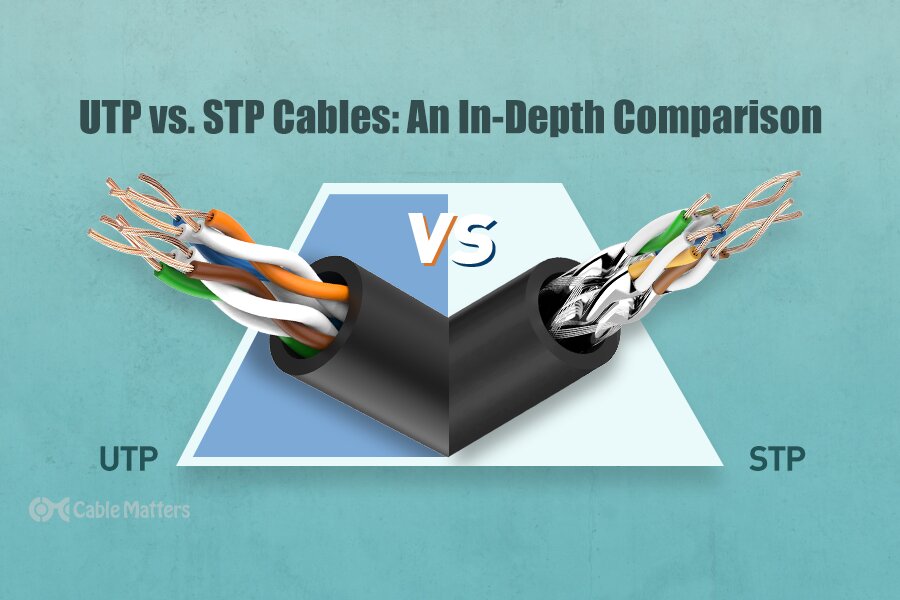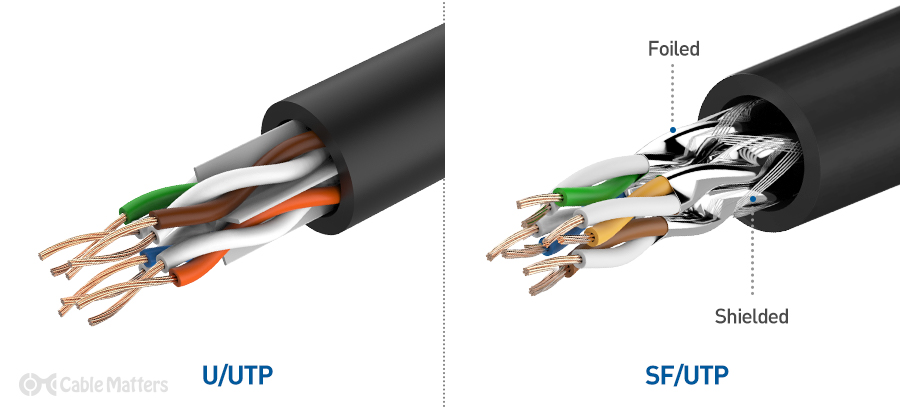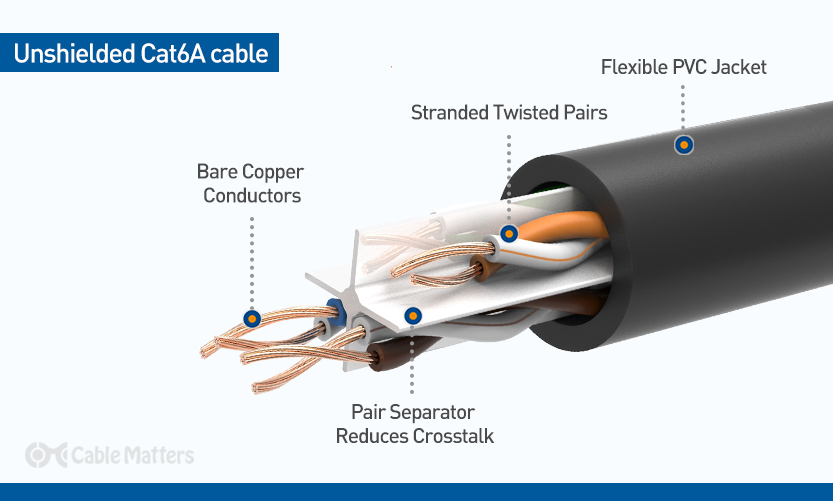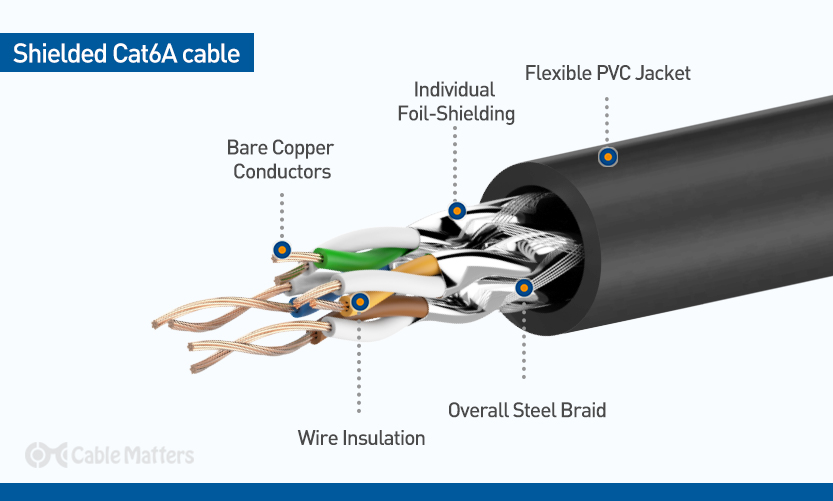
When it comes to running the cable for your network, there are a number of important decisions to make, not least of which is whether your cables require shielding, or not. That’s the UTP vs. STP debate in a nutshell, as the major difference between them is shielding. UTP is Unshielded Twisted Pairs, while STP is Shielded Twisted Pairs. While it might sound like common sense to always shield your cables, that’s not necessarily the case, as there are some very real reasons why in a UTP vs STP battle, UTP comes out on top.
Sometimes.
To see why, and why in other situations you must ensure your cables are shielded, here’s everything you need to know about UTP and STP cabling.
What Are UTP and STP?: Unshielded and Shielded Cables
Shielding is an important component of network cabling, as, without it, the data running through the cables stands a greater chance of being interfered with in some manner. For shorter runs, or where the data isn’t particularly important, that’s not necessarily a problem, but for important data, where its sanctity must be guaranteed, and especially if running longer cables, shielding is all but mandatory.
A UTP cable is made up of several twisted pairs of copper wires, with each pair wrapped in an insulator, with a further rubberized jacket around all of the wires together. They’re most commonly used in legacy phone line wiring, or in digital networks where shorter connections are required. Most modern, high-performance categories of Ethernet cable do use some form of shielding, however, so UTP cabling is becoming less common in computer networking as networks are upgraded with greater bandwidths in mind.
There are various different naming conventions used to describe STP cable shielding, though typically it’s with a prefix. Some cables are sold as S/UTP, which would be unshielded twisted pairs, but with a braid shield around them all. F/UTP would be the same, but with a foil shield. You can also get FTP cables, which are a subclass of STP, and denotes that they have foil-wrapped twisted pairs.
For more information on the different naming conventions of shielded cables, check out our guide to Shielded and Unshielded wiring.

Advantages of UTP Cables: Unshielded Twisted Pair
UTP cables are typically cheaper than their shielded counterparts, making them a great solution to your networking needs if you’re working within a tight budget. You aren’t having to pay for the additional metal within the cable that provides the braiding or foil wrap shielding. That lack of metal within the cable also makes UTP cables easier to work with, as they’re more malleable and considerably lighter. That makes installation easier, as you can route them through smaller spaces and around tighter corners, as well as making transportation of the bulk cabling cheaper and easier.
For professional installations, too, unshielded cables don’t require grounding at both ends, which makes installation easier and faster, again. Considering improperly grounded shielded cables can actually introduce interference and noise to the data as well, you can get away with less-skilled installation with UTP than you can with STP. There are fewer stringent steps involved in the process.
With an unshielded cable, you also have less fear of damage to the cabling over time. Where a shielded cable with a perforated shield may not be able to properly protect its data and therefore requires replacement, there is no expectation of unshielded cables, so they needn’t be replaced so readily.
Disadvantages of UTP
The main disadvantage of unshielded cables is their very nature: they are unshielded. That makes them far less suited for sensitive data like those carried by hospital networks, factories, airports, or military installations. It also makes them unsuited for busy environments where there is a lot of potential electromagnetic interference (EMI), or crosstalk from other wires within the network. Even having to run past HVAC systems, or radio transmitters can cause problems for UTP cabling.
The very twisted nature of unshielded twisted pairs does give them some minor protection against crosstalk, but if you are packing a lot of UTP cables together in a small space, there’s a chance you could end up with noise on the line.
You can limit the chance of UTP cables being affected by noise and EMI, but the chance of doing so successfully diminishes the more potential interference there is around the cabling, and when running the cables at longer lengths. Keeping a UTP cable run short is one of the best ways to improve its ability to protect your data.

Advantage of STP Cables: Shielded Twisted Pair
Shielded twisted pair cables offer much more robust protection for your data than UTP cables. STP cables feature the same twisted pairs, but often with individual foil wrapping of the pairs to add additional protection against EMI and crosstalk. Some cables also employ a plastic spline, which runs down the center of the wire and physically separates the twisted pairs, while others include a metallic braid that covers the entire collection of twisted pairs within the wire. There are also foil wrappers for all the twisted pairs, and combinations of each of these shielding options with and without the others.
The quantity and quality of shielding depend on the generation of Ethernet cable, and the manufacturer’s preferences. Some relatively old Cat 5e cables come with excellent shielding, while others will come with very little at all. Newer, more stringent Ethernet cable designs, like Cat 6a, and particularly Cat8 cables, require robust shielding as part of their specification, so tend to offer the best shielding.
The biggest advantage of this shielding is that the data running down the cables is better protected. If you have important information that absolutely must not be affected by exterior sources, STP cables will protect it for you. That can in turn help them support higher-speed cables, with greater data rates since more data can be packed down the cable without the additional risk of crosstalk. They can also run for longer lengths without interference, too.
Some shielding options, especially splines, and braids, can make a network cable far more robust, too, helping to avoid damage to it from bending or when pressure is placed on the cable from exterior sources.
The additional strength and shielding of STP cables make them perfectly suited for the most demanding environments where data must be protected, like medical centers, and airports. They’re also the best option if you need a long network cable, as STP can run longer than UTP without fear of interference.
Disadvantages of STP Cables
All the strengths of STP cables don’t come without any drawbacks, however. The shielding is almost always metallic, which means a lot of additional weight to the cable. That makes it more costly, harder to transport, and more complicated to install. It’s harder to lug around to where you need it, and the additional rigidity of the cable, although a benefit when it comes to protecting the internal wires, makes it much harder to run through tight spaces or round tight bends.
You have to pay for all that metal, too, which makes STP cables, particularly when purchased in large quantities, much more expensive than UTP cables. Although individual STP cables aren’t much more expensive than their UTP counterparts, with hundreds of meters of cabling, that cost quickly adds up.
The installation of these cables also requires grounding at both ends, which means the process takes longer, and is more complicated, requiring more technically proficient engineers to install it. That can lead to increased costs for the installer.
All of that means that STP isn’t a great fit for the home or smaller offices where interference isn’t so much of an issue. But if you’re looking to build out a hospital network, or want to run a very long cable, STP is the best choice by far, even with its disadvantages.

UTP vs. STP: Which Should You Choose?
In the UTP vs. STP debate, the right cable for you and your network very much depends on your particular needs and situation. If you are building a network with highly sensitive data in mind, and you expect the network to encounter a lot of interference from other cables or heavy machinery, and the network needs to be particularly large with long lengths of cable, then STP is the only way to go. Indeed, if you have any professional environment outside of the smallest of offices, then STP is likely the best choice.
The only reason you might opt for UTP in a professional environment is if the cable is ultimately too costly. Otherwise, STP provides a more robust cable solution that can run for longer, run at higher speeds, and guarantees the sanctity of your data as it travels down the cable.
For home, though? UTP is perfectly fine and will do just as good a job as STP. Particularly if there aren’t many sources of interference around. It’s cheaper, lighter, easier to install, and much easier to work with in general, making it simpler and quicker to expand your network or get it up and running.